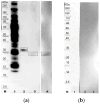Analysis of Trypanosoma equiperdum Recombinant Proteins for the Serological Diagnosis of Dourine
- PMID: 38535861
- PMCID: PMC10974970
- DOI: 10.3390/vetsci11030127
Analysis of Trypanosoma equiperdum Recombinant Proteins for the Serological Diagnosis of Dourine
Abstract
The significance of Trypanosoma equiperdum as the causative agent of dourine cannot be understated, especially given its high mortality rate among equids. International movement of equids should be subject to thorough health checks and screenings to ensure that animals are not infected with Trypanosoma equiperdum. This involves the implementation of quarantine protocols, testing procedures, and the issuance of health certificates to certify the health status of the animals. Three proteins, the peptidyl-prolyl cis-trans isomerase (A0A1G4I8N3), the GrpE protein homolog (A0A1G4I464) and the transport protein particle (TRAPP) component, putative (A0A1G4I740) (UniProt accession numbers SCU68469.1, SCU66661.1 and SCU67727.1), were identified as unique to T. equiperdum by bioinformatics analysis. The proteins were expressed as recombinant proteins and tested using an indirect ELISA and immunoblotting test with a panel of horse positive and negative sera for dourine. The diagnostic sensitivity, specificity and accuracy of the i-ELISAs were 86.7%, 53.8% and 59.0% for A0A1G4I8N3; 53.3%, 58.7% and 57.9% for A0A1G4I464; and 73.3%, 65.0% and 66.3% for A0A1G4I740, respectively, while the diagnostic sensitivity, specificity and accuracy of immunoblotting were 86.7%, 92.5% and 91.6% for A0A1G4I8N3; 46.7%, 81.3% and 75.8% for A0A1G4I464; and 80.0%, 63.8% and 66.3% for A0A1G4I740. Among the three proteins evaluated in the present work, A0A1G4I8N3 provided the best results when tested by immunoblotting; diagnostic application of this protein should be further investigated using a greater number of positive and negative sera.
Keywords: ELISA; dourine; immunoblotting; recombinant proteins.
Conflict of interest statement
The authors declare no conflicts of interest.
Figures


Similar articles
-
Trypanosoma equiperdum Low Molecular Weight Proteins As Candidates for Specific Serological Diagnosis of Dourine.Front Vet Sci. 2018 Mar 5;5:40. doi: 10.3389/fvets.2018.00040. eCollection 2018. Front Vet Sci. 2018. PMID: 29556505 Free PMC article.
-
IgG antibodies from dourine infected horses identify a distinctive Trypanosoma equiperdum antigenic pattern of low molecular weight molecules.Vet Immunol Immunopathol. 2013 Jan 15;151(1-2):140-6. doi: 10.1016/j.vetimm.2012.11.004. Epub 2012 Nov 14. Vet Immunol Immunopathol. 2013. PMID: 23218944
-
Development of an indirect ELISA for the serological diagnosis of dourine.Vet Parasitol. 2018 Sep 15;261:86-90. doi: 10.1016/j.vetpar.2018.08.014. Epub 2018 Sep 4. Vet Parasitol. 2018. PMID: 30253855
-
The current challenges of dourine: difficulties in differentiating Trypanosoma equiperdum within the subgenus Trypanozoon.Rev Sci Tech. 2003 Dec;22(3):1087-96. doi: 10.20506/rst.22.3.1460. Rev Sci Tech. 2003. PMID: 15005565 Review.
-
Trypanosoma equiperdum: master of disguise or historical mistake?Trends Parasitol. 2005 Jul;21(7):316-21. doi: 10.1016/j.pt.2005.05.010. Trends Parasitol. 2005. PMID: 15923142 Review.
Cited by
-
Animal Trypanosomiasis: Challenges and Prospects for New Vaccination Strategies.Microorganisms. 2024 Dec 13;12(12):2575. doi: 10.3390/microorganisms12122575. Microorganisms. 2024. PMID: 39770779 Free PMC article. Review.
References
-
- World Organisation for Animal Health, editor. Manual of Diagnostic Tests and Vaccines for Terrestrial Animals. World Organisation for Animal Health; Paris, France: 2021. Chapter 3.6.3. Dourine in horses (Trypanosoma equiperdum infection) pp. 1–13.
-
- Sidney R., Andrew M.G., James C., Richard N. Dourine–an emerging venereal threat to European horses. AHT/BEVA/DEFrA Equine Q. Dis. Surveill. Rep. 2013;6:7.
-
- Desquesnes M., Holzmuller P., Lai D., Dargantes A., Lun Z., Jittaplapong S. Trypanosoma evansi and Surra: A Review and Perspectives on Origin, History, Distribution, Taxonomy, Morphology, Hosts, and Pathogenic Effects. Biomed Res. Int. 2013;2013:194176. doi: 10.1155/2013/194176. - DOI - PMC - PubMed
Grants and funding
LinkOut - more resources
Full Text Sources

